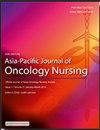Risk factors associated with immune-related severe adverse events in patients with cancer: A scoping review
IF 2.4
3区 医学
Q1 NURSING
引用次数: 0
Abstract
Objective
Increasing reports of immune-related severe adverse events (ir-SAEs) among patients with cancer treated with immune checkpoint inhibitors (ICIs) have raised significant concerns regarding patient safety. Although considerable research has addressed immune-related adverse events (irAEs), the risk factors specifically associated with ir-SAEs remain less well defined. This study aims to identify and synthesize the risk factors contributing to ir-SAEs in patients with cancer.
Methods
Adhering to the Joanna Briggs Institute scoping review guidelines, we conducted a comprehensive literature search across multiple databases including PubMed, Embase, Web of Science, ProQuest Dissertations and Theses, Clinical Trials, China Biomedical Literature Database, CNKI, Wanfang Database, and VIP Database. Studies published from the inception of each database up to 28 January 2024 were considered. Two independent reviewers screened the literature and extracted the relevant data.
Results
A total of 41 studies were included, comprising 20 retrospective case-control studies, 9 retrospective cohort studies, 8 prospective cohort studies, and 4 meta-analyses. The analysis identified three primary categories of risk factors: demographic factors, disease-related factors, and laboratory examination-related factors.
Conclusions
A diverse range of risk factors is associated with ir-SAEs in patients with cancer. Enhancing the education of clinical oncology nurses regarding these risk factors may facilitate early identification and management of high-risk groups, thereby improving patient safety. Given the observed inconsistencies among studies, further research is warranted to elucidate risk factors with high predictive value for ir-SAEs.
癌症患者中与免疫相关的严重不良事件相关的危险因素:范围综述
在接受免疫检查点抑制剂(ICIs)治疗的癌症患者中,越来越多的免疫相关严重不良事件(ir-SAEs)的报道引起了对患者安全的重大关注。尽管大量研究已经解决了免疫相关不良事件(irAEs),但与免疫相关不良事件相关的风险因素仍然不太明确。本研究旨在识别和综合导致癌症患者ir-SAEs的危险因素。方法根据Joanna Briggs Institute的文献综述指南,在PubMed、Embase、Web of Science、ProQuest博士论文、临床试验、中国生物医学文献数据库、中国知网、万方数据库、VIP数据库等多个数据库进行全面的文献检索。从每个数据库建立到2024年1月28日为止发表的研究都被考虑在内。两名独立审稿人筛选文献并提取相关数据。结果共纳入41项研究,包括20项回顾性病例对照研究、9项回顾性队列研究、8项前瞻性队列研究和4项荟萃分析。分析确定了三种主要的危险因素:人口因素、疾病相关因素和实验室检查相关因素。结论多种危险因素与肿瘤患者ir-SAEs相关。加强临床肿瘤学护士对这些危险因素的教育,有助于早期识别和管理高危人群,从而提高患者安全。鉴于观察到的研究之间的不一致性,需要进一步的研究来阐明对ir-SAEs具有高预测价值的危险因素。
本文章由计算机程序翻译,如有差异,请以英文原文为准。
求助全文
约1分钟内获得全文
求助全文
来源期刊

Asia-Pacific Journal of Oncology Nursing
Multiple-
CiteScore
2.80
自引率
11.10%
发文量
136
审稿时长
31 days
 求助内容:
求助内容: 应助结果提醒方式:
应助结果提醒方式:


